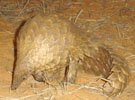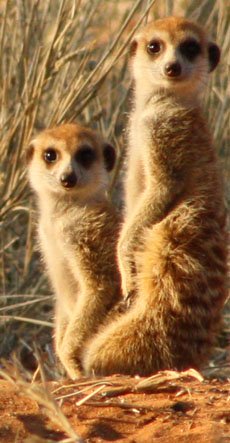Namibian Gold
by Stephan Hofmann
(Illinois, USA)
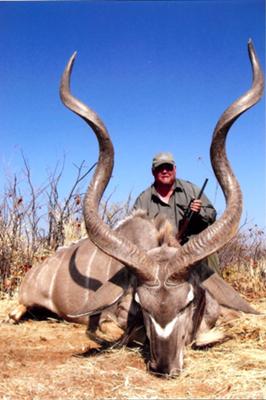
56" Kudu in Namibia
I had hunted hard for three days in the Mopane woodlands, savannahs and rocky hills of Northern Namibia with Barry as my PH.
I had not, as yet, harvested an animal. I was using a Ruger .300 Win Mag to assure that I would be able to take long shots and that I had the firepower to put down any Plains Game that I encountered.
For three days we had hunted with no success on Barry's ranch which contained extremely dense vegetation. It was difficult to spot an animal in the dense bush, much less shoot one.
Barry assured me the animals were there but they were difficult to hunt. We did see 17 young Kudu bulls at a waterhole, but no shooters.
On day five, Barry and I went to another ranch to hunt. This ranch was noted for it's extremely good Kudu. The Southern Greater Kudu on this ranch were known to reach horn lengths of 60 inches. The ranch was called Janni's Farm and it contained 50,000 acres of Mopane, Acacia scrub, and savannah areas. Barry said Janni’s Farm was more wide open than his ranch.
We left early in the morning after warming up before the fire in the Boma and drinking some coffee. When we arrived at Janni’s Farm we immediately saw a Gemsbok in the tall grass. Barry said that it was a small one. I looked at the Gemsbok's headgear through my Leupold scope and it looked like a male with stout horns with large ridges at their bases. The tall grass concealed the animal's sex.
I told Barry that I thought it was a bull and that it was a shooter. The animal was quartering away from us. We followed it a bit and I decided to try a shot. The Gemsbok was about 120 yards away. I placed my crosshairs on the Gemsbok's right shoulder and squeezed off a shot. The Gemsbok collapsed to the ground. Barry said "Good shooting!! I guess you wanted that one!!"
We walked up to the Gemsbok and he was, indeed, a bull. He had a very nice pair of horns. Barry measured the horns and they were of Gold Medal quality for Namibia as determined by NAPHA. Barry congratulated me again.
We went to Janni's homestead and gave the Gemsbok to the skinners. Janni and his wife were in Windhoek. Janni had a large walk in cooler where he stores his harvested game meat. He sells the meat to restaurants in Windhoek.
We continued to hunt. I really was excited now that I had harvested my first African bull Gemsbok. I wanted a Kudu. I believe that every hunter that goes on Safari to Africa would like to shoot a Kudu. I believe that Hemingway took 17 days to harvest a Kudu in his novel, The Green Hills of Africa. I certainly did not want to take that long!!
We were approaching a large waterhole. Hundreds of Guinea Fowl were running around the waterhole. We saw three Kudu cows drinking at the waterhole. Suddenly we heard the distinctive barking of a male Kudu. About 270 yards away two Kudu bulls were moving to our left. "Bull!!", I hoarsely whispered to Barry.
The Kudus stopped and I got a good look at them. I placed the crosshairs of my scope on the largest bull, used my rifle's bipod to steady my aim, and slowly squeezed the trigger. The Kudu staggered a bit and fell to the ground. "Well done!!", said Barry.
When we got close to the Kudu, he was magnificent. Barry measured his horns and they were 56 inches, another Namibian Gold Medal!! Barry gave me a Cuban Cigar to celebrate my first Kudu. I had shot the Kudu five days into my safari; I had beaten Hemingway!!
We went back to the homestead and decided to have lunch. Barry went into the walk in cooler and sliced off a large hunk of Gemsbok steak from the animal that I had killed earlier that morning. Janni had a huge brick Bar B Que or Braai and we grilled the steak while the skinners were at work on my Kudu. The steak was a wonderful meal.
After a midday rest we went out again. We went to another waterhole with an elevated blind nearby. We walked up the steep steps to the blind and awaited any shootable animal that came to the water. After no more than one half hour, a herd of Warthogs approached the water. Barry said there was a large boar in the group but it had only one tusk. He said it was a good Warthog even if one tusk was broken off. I waited until the boar started to drink, then shot him at 80 yards through the heart. He dropped with his face in the water. "Well done!!", said Barry.
We climbed out of the blind and went up to the Warthog. I have to tell you that up close Warthogs are the ugliest animals that I have ever seen!! Barry measured the one tusk and it was of Gold Medal quality. By the rules of NAPHA, only one tusk must be measured.
I was overjoyed!! Three Gold Medal animals in one day!!
The sun was beginning to set. We were searching for another Kudu. I wanted to harvest another bull Kudu for an extra trophy fee outside of my hunt package. All of a sudden, my tracker, Yassir, pointed to the thorny brush to our left and said, "Kudu".
I could not make out the Kudu. Barry said that he could see the grey body of the bull through the Acacia brush under a Mopane tree. The bull was standing perfectly still. I used my scope at 8 power and could see nothing but a wide ear that flickered nervously. I was amazed at the eyesite of Barry and Yassir. The Grey Ghost of Africa did not evade their keen vision.
The Kudu was about 100 yards away. We tried to walk around the Kudu and surprise it. The bull sensed our movement, left it's secure spot under the Mopane tree, and started to run straight away from us. At 160 yards I took a shot. I believe I missed. I chambered another round and shot again. This time I hit the Kudu in the spine with a 180 gr Cor Lokt bullet. He collapsed to the ground. I had connected on a running shot at 170 yards!!. "Great shot!!", said Barry. "You are making your shots count!!"
We walked up to the Kudu and he was a beauty. Barry measured his horns and they were a respectable 54 inches; another Namibian Gold Medal!!
Barry and I smoked our Cuban cigars and congratulated each other on a splendid hunt.
For me, it was the hunt of a lifetime.
It had been a wonderful day for me in Namibia.
I had harvested four Gold Medal animals!! I had struck Namibian Gold.
Stephan Hofmann
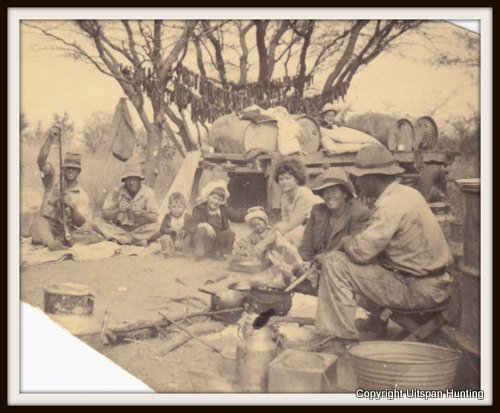
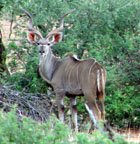
 Some animals have one sense more than man!The flehmen response is a particular type of curling of the upper lip in ungulates, felids and many other mammals. This action facilitates the transfer of pheromones and other scents into the vomeronasal organ, also called the Jacobson's Organ.
Some animals have one sense more than man!The flehmen response is a particular type of curling of the upper lip in ungulates, felids and many other mammals. This action facilitates the transfer of pheromones and other scents into the vomeronasal organ, also called the Jacobson's Organ.

